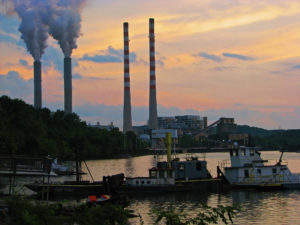
Smog has historically been the term for smoke and fog.
Today, the definition has a little more accountability. Smog is produced when sunlight mixes with pollution from the fossil fuel industry, cars and factories, and the technical term for it is ground-level ozone pollution.
Ozone can be good or bad. Ozone in the stratosphere reduces harsh sunlight, but ozone close to Earth’s crust is unhealthy for animals and plants.
The next big effort to reduce this polluting haze in the U.S. is just getting underway. Last week, the Environmental Protection Agency announced its “Good Neighbor” rule to address the polluters causing smog downwind in other states.
Tennessee was deferred from this rule.
What is the Good Neighbor rule?
 Roger Smith Flickr
Roger Smith FlickrCoal plants like the Tennessee Valley Authority’s Cumberland Fossil Plant emit large amounts of nitrogen oxides, one of the main ingredients in smog.
The Clean Air Act requires the Environmental Protection Agency to regulate some pollutants by establishing National Ambient Air Quality Standards. The main six pollutants are carbon monoxide, lead, particulate matter, ozone, nitrogen dioxide and sulfur dioxide.
With this new rule, EPA is setting new limits on nitrogen oxides, a key component of ozone. Ozone is formed when nitrogen oxides react with sunlight and at least one volatile organic compound, such as gasoline.
States must comply with these limits. Once a new air quality standard is created, states must submit plans to meet that air quality requirement and avoid causing ozone problems in downwind states.
Since air pollution is not stagnant, EPA has the “Good Neighbor Plan.” A coal plant in Tennessee can affect the air quality in North Carolina, for example.
“Air pollution doesn’t care about state lines,” said Zachary Fabish, a senior attorney at Sierra Club.
EPA determined that 23 states did not have adequate state plans — many states did not even include emissions reductions in their plans — and created plans for those states.
Tennessee was deferred from the new rule until December. In the final rule, EPA said its reevaluating Tennessee’s current plan to cut pollution.
“For three states, EPA’s updated analysis for this final rule suggests further analysis is warranted. EPA is deferring or reevaluating final action for these states and intends to address their Good Neighbor requirements as appropriate in a separate action or actions: Arizona, Tennessee, and Wyoming,” James Pinkney, a spokesperson for EPA, said in a statement.
What about TVA?
While the state has been deferred, the Tennessee Valley Authority may be affected by the rule.
Kentucky is one of the states under mandate to reduce pollution during each ozone season, which runs from March to October in Kentucky. EPA has set limits on how much nitrogen oxide (NOx) emissions the state can produce each season from 2023 to 2029.
By the end of the decade, Kentucky has a limit of 7,392 tons of NOx. TVA’s Shawnee Fossil Plant, a coal plant in Paducah, produced 3,500 tons of NOx during the 2021 ozone season, and about 2,700 tons in 2022. TVA has indicated that the Shawnee will be the last coal plant it retires in 2033.
TVA already has pollution controls on the Kentucky plant. A Clean Air Act lawsuit settled in 2011 forced TVA to install devices meant to reduce NOx and sulfur dioxide at 11 of its coal plants. TVA runs this pollution control whenever the plant is operating, TVA’s Scott Brooks said.
EPA’s accompanying analysis of its plan estimates that an additional 14 gigawatts of coal capacity, or a 13% cut in national coal capacity, will result directly from this rule by 2030.
The power sector had previously protested the rule and claimed that fossil fuel retirements could threaten grid reliability. EPA provided a new framework to maintain reliability during the shift and expects an additional 3 gigawatts of renewables added in 2025 because of the rule.
Lawsuits challenging the rule are expected.
The rule goes beyond coal plants
The Good Neighbor plan addresses some emissions sources from the broader fossil fuel sector as well as various industries.
EPA lists the following emission sources as being subject to reduction measures:
- reciprocating internal combustion engines in Pipeline Transportation of Natural Gas;
- kilns in Cement and Cement Product Manufacturing;
- reheat furnaces in Iron and Steel Mills and Ferroalloy Manufacturing;
- furnaces in Glass and Glass Product Manufacturing;
- boilers in Iron and Steel Mills and Ferroalloy Manufacturing, Metal Ore Mining, Basic Chemical Manufacturing, Petroleum and Coal Products Manufacturing, and Pulp, Paper, and Paperboard Mills; and
- combustors and incinerators in Solid Waste Combustors or Incinerators.
How bad is smog in Nashville?
Nashville ranks 66th in the nation for the number of high ozone days, according to the American Lung Association. The number of high ozone days has decreased significantly in the past few decades.
The city experienced several ozone alerts during an intense heat wave last June, when the city hit 100 degrees for the first time in a decade.

